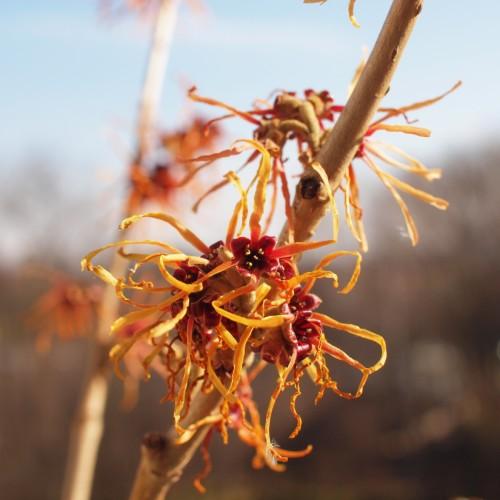
witch hazel
Hamamelis intermedia 'Jelena'
Cycle:
Perennial
Watering:
Average
Hardiness Zone:
5 - 8
Flowers:
Flowers
Sun:
Full sun,part shade
Leaf:
Yes
Growth Rate:
Low
Maintenance:
Low
Drought Tolerant:
Yes
Care Level:
Medium
watering
Witch hazel does best in moist but well-drained soils that are rich in organic matter. During the summer months, water your witch hazel deeply and slowly once a week, allowing the top 2-3 inches of soil to dry out before watering in order to prevent root rot. During the cooler months, you can reduce the frequency of watering, allowing the soil to dry out more. Aim to water your witch hazel no more than once every 2 weeks. Keep an eye on your plant over the winter months, as extremely cold temperatures may require more frequent watering.
sunlight
Witch hazel (Hamamelis intermedia 'Jelena') is a deciduous shrub which prefers to grow in full sun. It requires at least 5 to 6 hours of direct sunlight every day. Witch hazel thrives best in an environment with plenty of direct sunlight during the day. When grown in direct sunlight, plants will show more blooms and healthier foliage. In areas with little sunlight, witch hazel may struggle to develop into the full shrub that it is capable of otherwise becoming. In the southern half of the United States, witch hazel can be grown in mostly full sunlight for most of the year. In the northern half of the United States, witch hazel should be provided with at least 5 to 6 hours of direct sunlight during the spring and summer months, and slightly reduced direct sunlight during the winter months.
pruning
Witch hazel (Hamamelis intermedia 'Jelena') should be pruned in early spring, before it breaks its winter dormancy. The ideal time to prune witch hazel is in late February or early March. As with other deciduous shrubs, witch hazel benefits from the removal of any diseased, damaged, or deadwood branches. In addition, witch hazel should also be pruned to reduce the size and shape the shrub as necessary. When pruning, do not take too much wood off in at a time as this can put the shrub under stress. Instead, prune the shrub in stages, such as by taking off no more than 1/3 each year. This will allow for more natural, attractive growth and will help promote healthier, longer-lasting branches.
